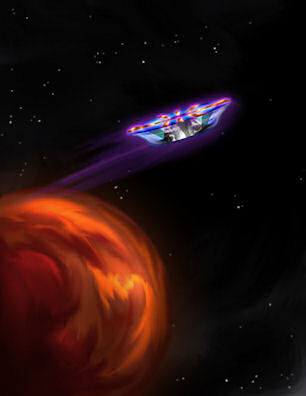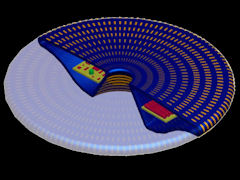Professor Designs Plasma Driven UFO
 University
of Florida mechanical and aerospace engineering
associate professor Subrata Roy has
recently applied for a patent
to build a circular aircraft that can hover in the
air like a helicopter without any moving parts or
fuel.
University
of Florida mechanical and aerospace engineering
associate professor Subrata Roy has
recently applied for a patent
to build a circular aircraft that can hover in the
air like a helicopter without any moving parts or
fuel.
The saucer will hover and propel itself using
electrodes that cover its surface to ionize the
surrounding air into plasma. Gases (such as air,
which has an equal number of positive and negative
charges) become plasma when energy (such as heat or
electricity) causes some of the gas's atoms to lose
their negatively charged electrons, creating atoms
with a positive charge, or positive ions, surrounded
by the newly detached electrons.
Using an onboard source of
energy (such as a battery, ultra-capacitor
or a solar panel) the electrodes will send an
electrical current into the plasma, causing the
plasma to push against the neutral (noncharged) air
surrounding the craft, theoretically generating
enough force for lift off and movement in different
directions (depending on where on the craft's
surface you direct the electrical current)
At six inches (15.2 centimetres) in diameter, the
device, which Roy calls a "wingless electromagnetic
air vehicle" (WEAV),
will truly be a flying saucer. Theoretically, Roy
says, the flying saucer can be as large as anyone
wants to build it, because the design gives the
aircraft balance and stability. In other words, this
type of aircraft could someday be built large enough
to ferry around people. But, Roy says, "we need to
walk before we can run, so we're starting small."
The biggest hurdle to building a WEAV large enough
to carry passengers would be making the craft light,
yet powerful enough to lift its cargo and energy
source. Roy is not sure what kind of energy source
he will use yet. He anticipates that the craft's
body will be made from a material that is an
insulator such as ceramic, which is light and a good
conductor of electricity. "In theory you probably
should be able to scale it up," says Anthony Colozza,
a researcher who is stationed at NASA's Glenn
Research Centre in Cleveland and helped Roy draw up
the original plans for powering the saucer. The
choice of a power source that is powerful, yet
lightweight is "probably going to be the thing that
makes or breaks it."
Roy
began designing the WEAV in 2006. The following
year, he and Colozza wrote a paper for the
now-defunct NASA Institute for Advanced Concepts
(NIAC) about the use of electro-hydrodynamics, or
ionized particles, as an alternative to liquid fuel
for powering space vehicles. When NASA shut down
NIAC in August 2007, Roy decided to continue his
work at U.F.
 If
he's successful, Roy hopes to develop a more stable
aircraft and a new form of fuel—air. Other craft
that interact with the atmosphere have a problem:
moving parts, whether jet engines, propellers or
rotors. "My interest started when I saw inherent
problems in helicopters and airplanes," Roy says. If
these parts stop moving, the aircraft falls from the
sky. The flying saucer, on the other hand, has no
moving parts.
If
he's successful, Roy hopes to develop a more stable
aircraft and a new form of fuel—air. Other craft
that interact with the atmosphere have a problem:
moving parts, whether jet engines, propellers or
rotors. "My interest started when I saw inherent
problems in helicopters and airplanes," Roy says. If
these parts stop moving, the aircraft falls from the
sky. The flying saucer, on the other hand, has no
moving parts.
In theory, the WEAV would be more stable than an
aircraft—airplanes and helicopters, for example—that
rely on aerodynamics to provide lift.
Using a plasma field, "you
could produce lift in any direction, you could
change direction quickly and that power could be
turned on or off almost instantly," Colozza says. If
the pilot wanted such an aircraft to move to the
right, he or she would increase power to electrodes
on the left side of the craft and vice versa for
moving to the left. Electrodes on the bottom of the
craft would power its lift, whereas those on top
would bring the craft back down to Earth.
Roy has been working with the U.S. Air Force
Research Laboratory at
Wright-Patterson Air Force Base in Dayton, Ohio,
since 2001 to study how plasma could be used to
control the flow of air—pushing air in different
directions - and thereby the vehicle's movements.
"If plasma (flow) is turned on the right way, I can
blow air any direction I want to blow air," says
Doug Blake, deputy director of the Air Force
Research Lab's Air Vehicles Directorate,
of the craft's ability to push air away from itself.
"If I have a jet coming out of the bottom of this, I
can create a helicopter with no moving parts. Things
that you would use a helicopter for, you could use
this for."

 University
of Florida mechanical and aerospace engineering
associate professor Subrata Roy has
recently applied for a patent
to build a circular aircraft that can hover in the
air like a helicopter without any moving parts or
fuel.
University
of Florida mechanical and aerospace engineering
associate professor Subrata Roy has
recently applied for a patent
to build a circular aircraft that can hover in the
air like a helicopter without any moving parts or
fuel.